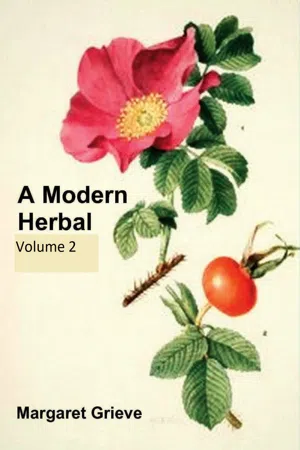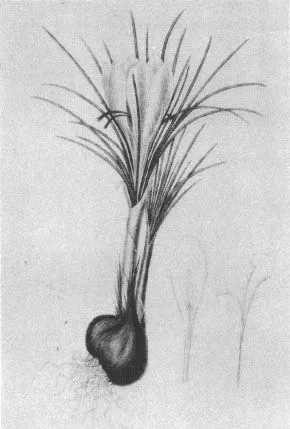
eBook - ePub
A Modern Herbal (Volume 2)
Margaret Grieve
This is a test
Condividi libro
- English
- ePUB (disponibile sull'app)
- Disponibile su iOS e Android
eBook - ePub
A Modern Herbal (Volume 2)
Margaret Grieve
Dettagli del libro
Anteprima del libro
Indice dei contenuti
Citazioni
Informazioni sul libro
"There is not one page of this enchanting book which does not contain something to interest the common reader as well as the serious student. Regarded simply as a history of flowers, it adds to the joys of the country." — B. E. Todd, SpectatorVolume 2 of the fullest, most exact, most useful compilation of herbal material. Gigantic alphabetical encyclopedia, from aconite to zedoary, gives botanical information, medical properties, folklore, economic uses, much else. Indispensable to serious reader. 161 illustrations.
Domande frequenti
Come faccio ad annullare l'abbonamento?
È semplicissimo: basta accedere alla sezione Account nelle Impostazioni e cliccare su "Annulla abbonamento". Dopo la cancellazione, l'abbonamento rimarrà attivo per il periodo rimanente già pagato. Per maggiori informazioni, clicca qui
È possibile scaricare libri? Se sì, come?
Al momento è possibile scaricare tramite l'app tutti i nostri libri ePub mobile-friendly. Anche la maggior parte dei nostri PDF è scaricabile e stiamo lavorando per rendere disponibile quanto prima il download di tutti gli altri file. Per maggiori informazioni, clicca qui
Che differenza c'è tra i piani?
Entrambi i piani ti danno accesso illimitato alla libreria e a tutte le funzionalità di Perlego. Le uniche differenze sono il prezzo e il periodo di abbonamento: con il piano annuale risparmierai circa il 30% rispetto a 12 rate con quello mensile.
Cos'è Perlego?
Perlego è un servizio di abbonamento a testi accademici, che ti permette di accedere a un'intera libreria online a un prezzo inferiore rispetto a quello che pagheresti per acquistare un singolo libro al mese. Con oltre 1 milione di testi suddivisi in più di 1.000 categorie, troverai sicuramente ciò che fa per te! Per maggiori informazioni, clicca qui.
Perlego supporta la sintesi vocale?
Cerca l'icona Sintesi vocale nel prossimo libro che leggerai per verificare se è possibile riprodurre l'audio. Questo strumento permette di leggere il testo a voce alta, evidenziandolo man mano che la lettura procede. Puoi aumentare o diminuire la velocità della sintesi vocale, oppure sospendere la riproduzione. Per maggiori informazioni, clicca qui.
A Modern Herbal (Volume 2) è disponibile online in formato PDF/ePub?
Sì, puoi accedere a A Modern Herbal (Volume 2) di Margaret Grieve in formato PDF e/o ePub, così come ad altri libri molto apprezzati nelle sezioni relative a Biological Sciences e Horticulture. Scopri oltre 1 milione di libri disponibili nel nostro catalogo.
Informazioni
Argomento
Biological SciencesCategoria
HorticultureSABADILLA
Veratrum sabadilla
N.O. Liliaceae
Synonyms. Cevadilla. Schcenocaulon officinale. Melanthium sabadilla. Veratrum officinale. Helonias officinalis. Sabadilla officinarum. Asagraea officinalis. Sabadillermer
parts used. Seeds, dried fruit
Habitat. Southern north america, guatemala and venezuela


Two other alkaloids have been isolated: sabadine, which is less sternutatory than veratrine, and sabadinine, which is not sternutatory. Sabadilla yields about 0-3 per cent, of veratrine. The seeds also contain veratric acid, cevadic acid, fat and resin.



SAFFLOWER
Carthamus tinctorius
N.o. Compositae
Synonyms. Dyer’s saffron. American saffron. Fake saffron. Flores carthami. Bastard Saffron
part used. Flowers
This plant is not in any way related to saffron, though the flowers are used similarly.1
The safflower plant, known in india as koosumbha and in china as hoang-tchi, is extensively cultivated in india, china and other parts of asia, also in egypt and southern europe; but its native country is unknown. It grows about 2 to 3 feet high, with a stiff, upright whitish stem, branching near the top; and has oval, spiny, sharp-pointed leaves, their bases half-clasping the stem. Its fruits are about the size of barleycorns, somewhat four-sided, white and shining, like little shells.
Safflower contains two colouring matters, yellow and red, the latter being most valued.
It is chiefly used for dyeing silk, affording various shades of rose and scarlet. Mixed with finely-powdered talc it forms the well-known substance called ‘rouge.’ another common use of safflower is in adulterating saffron. The seeds yield an oil much used in india for burning and for culinary purposes.

SAFFRON
Crocus sativus
N.o. Iridaceae
Synonyms. Crocus. Karcom. Krokos (arabian) zaffer
part used. Flower pistils
The true saffron is a low ornamental plant with grass-like leaves and large lily-shaped flowers, inhabiting the european continent, and frequently cultivated for the sake of the yellow stigmas, which are the part used in medicine, in domestic economy and in the arts.
Saffron is the karcom of the hebrews (song of solomon iv. 14). The plant was also known to the ancient greeks and romans.
In the course of an inquest held in 1921 at Poplar (london, e.), a medical witness testified to the prevalence of a domestic custom of giving saffron ‘tea’ flavoured with brandy in cases of measles.
The Emplastrum oxycroceum of the edinburgh pharmacopœia contained, in olden days, a large proportion of saffron (from which – and vinegar – it derived its name), with the addition of colophony, gum am-moniacum, mastic and vinegar.
Saffron was imported to england from the East many centuries ago, and was once grown extensively round saffron walden, in essex. One smoke-pervaded spot in the heart of london still bears the name of ‘saffron hill.’ it is a somewhat expensive product, the economic value residing in the stigmas of the flower, of which it is said 60,000 are needed to make 1 lb. Of saffron.

Saffron Crocus Sativus

Meadow saffron colchicum autumnale
According to dr. Pereira, a grain of good commercial saffron contains the stigmas and styles of nine flowers, and consequently 4,320 flowers are required to yield 1 oz. Of saffron! English-grown saffron is now very seldom met with in commerce; the best comes from spain, while that imported from france is usually considered of second-rate quality. The quantity imported has been computed at between 5,000 and 20,000 lb. Weight per annum. Saffron has a bitter taste and a penetrating aromatic odour.
Lately, persian saffron has made its appearance in the english market – although of rare occurrence – owing to the high and increasing price of the european article. It has long been known as a wild product of persia, and was formerly sent from that country and kashmir to bombay, -but was driven out of the market by the superior saffrons of europe.
Saffron was cultivated at derbena and ispahan in persia in the tenth century. It differs a little in appearance from european saffron in being rather more slender and in the unbranched part of the style being paler, but the characteristic odour is remarkably strong. On immersion in water it does not seem to give out so much colour as european saffron, and could only compete with it if the price enabled it to be used in sufficient quantity to give a colour equal to that used in europe. The wild persian crocus is the variety hausknechtii, which occurs on the delechani and sangur mountains between kermanshah and hamada in west persia, and at karput in kurdistan, which is the most easterly point where any form of crocus sativus occurs in the wild state.
It may be mentioned that five forms of c. Sativus are known in the wild state. (1) var. Orsiniiy which may be regarded as the italian form and is found at ascoli, the most westerly point from which any wild form of the plant is recorded. It near...